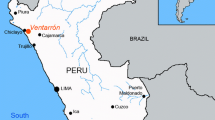Abstract
Raman microspectroscopy combined with scanning electron microscopy was applied to the investigation of the Madonna and Child Enthroned with Saints of Ambrogio Lorenzetti (early 14th century; St. Augustine church, Siena, Italy). A detailed investigation of both the materials used for the wall painting and the alteration products was provided in order to increase the level of accessibility of this masterpiece and to stimulate its restoration. The results showed that the pigments used for this wall painting were those widely used by medieval painters: chalk white, white lead, yellow ochre, red ochre, red lead, cinnabar, Siena earth, green earth, verdigris, azurite, and carbon black. Gilded tin foil has been further used for the decoration of the haloes. The alteration products mainly consist of Ca sulfates and Ca oxalates. Fungal spores were further observed in correspondence to the application of lead-based pigments.








Similar content being viewed by others

References
Bicchieri M, Nardone M, Russo PA, Sodo A, Corsi M, Cristooretti G, Palleschi V, Salvetti A, Tognoni E (2001) Characterization of azurite and lazurite based pigments by laser-induced breakdown spectroscopy and micro-Raman spectroscopy. Spectrochim Acta B 56:915–922
Brogi A, Milazzo M, Torriti P (2000) II cofano nuziale istoriato attribuito ad Ambrogio Lorenzetti. Electa, Milan
Chaplin TD, Clark RJH, Jacobs D, Jensen K, Smith GD (2005) The Gutenberg Bibles: analysis of the illuminations and inks using Raman spectroscopy. Anal Chem 77:3611–3622
Chaplin TD, Clark RJH, McKay A, Pugh S (2006a) Raman spectroscopic analysis of selected astronomical and cartographic folios from the early 13th century Islamic ‘Book of Curiosities of the Sciences and Marvels for the Eyes’. J Raman Spectrosc 37:865–877
Chaplin TD, Clark RJH, Scott DA (2006b) Study by Raman microscopy of nine variants of the green–blue pigment verdigris, J. Raman Spectrosc 37:223–229
Conti C, Aliatis I, Colombo C, Greco M, Possenti E, Realini M, Castiglioni C, Zerbi G (2012) μ-Raman mapping to study calcium oxalate historical films. J Raman Spectrosc 43:1604–1611
Fei A (1997) Le “preziose” terre di Arcidosso e Castel del Piano (Grosseto). Atti del Museo di Storia Naturale della Maremma 16:141–161
Froment F, Tournié A, Colomban P (2008) Raman identification of natural red to yellow pigments: ochre and iron-containing ores. J Raman Spectrosc 39:560–568
Frost R (2003) Raman spectroscopy of selected copper minerals of significance in corrosion. Spectrochim Acta A 59:1195–1204
Frost RL, Jing Y, Ding Z (2003) Raman and FTIR spectroscopy of natural oxalates: implications for the evidence of life on Mars. Chinese Sci Bull 48:1844–1852
Gadd GM (2000) Heterotrophic solubilization of metal-bearing minerals by fungi. Mineral Soc Ser 9:57–75
Gettens RJ, Mrose ME (1954) Calcium sulphate minerals in the grounds of Italian paintings. Stud Conserv 1:175–1899
Gettens RJ, West Fitzhugh E (1966) Azurite and blue verditer. Stud Conserv 11:54–61
Gettens RJ, Feller RL, Chase WT (1993) Vermilion and cinnabar. Artists’ pigments: a Handbook of their history and characteristics 2. National Gallery of Art and Oxford University Press, Washington, DC, Oxford, p 159
Hernanz A, Gavira-Vallejo JM, Ruiz-López JF (2007) Calcium oxalates and prehistoric paintings. The usefulness of these biomaterials. J Optoelectron Adv M 9:512–521
Keune K, Boon JJ (2005) Analytical imaging studies clarifying the process of the darkening of vermilion in paintings. Anal Chem 77:4742–4750
Lamprecht I, Reller A, Riesen R, Wiedemann HG (1997) Ca-oxalate films and microbiological investigations of the influence of ancient pigments on the growth of lichens. J Therm Anal 49:1601–1607
Lazzarini L, Salvadori O (1989) A reassessment of the formation of patina called scialbatura. Stud Conserv 34:20–26
Marabelli M, Santopadre P, Ioele M, Cesareo R, Castellano A, Verità M (2005) Le lamine metalliche utilizzate nella decorazione dei dipinti murali giotteschi. Bollettino d'Arte, Rome, p 121–144
Mattei E, De Vivo G, De Santis A, Gaetani C, Pelosi C, Santamaria U (2008) Raman spectroscopy analysis of azurite blackening. J Raman Spectrosc 39:302–306
Matteini M, Giovannoni S (1996) The protective effect of ammonium oxalate treatment on the surface of wall paintings. In: Painted facades. Proceedings of the Eurocare Project, Vienna 1996, pp 95–101
Ospitali F, Bersani D, Di Lonardo G, Lottici PP (2008) ‘Green earths’: vibrational and elemental characterization of glauconites, celadonites and historical pigments. J Raman Spectrosc 39:1066–1073
Pitarch A, Álvarez-Pérez A, Castro K, Madariaga JM, Queralt I (2012) Raman analysis assessed by Fourier-Transformed infrared and X-ray fluorescence spectroscopies: a multi-analytical approach of ancient chromolithographs from the 19th century. J Raman Spectrosc 43:411–418
Riedl, P. A., Seidel, M. (ed) (1985) Die Kirchen von Siena, München, vol. I, pp 114
Sayre, EV (1970) Investigation of Italian frescoes, their materials deterioration and treatment. In: Application of science in examination of works of art, Proceedings of the Seminar, Sept. 7–16, 1965. Museum of Fine Arts, Boston, Mass. 1967, pp 176–181
Scarsella P, Natale P (1998) Terre colorate naturali e tinte murali a base di terre. Stamperia Artistica nazionale, Torino
Smith GD, Clark RJH (2002) The role of H2S in pigment blackening. J Cult Herit 3:101–105
Vandenabeele P, Moens L (2004) Chapter 14. Pigment identification in illuminated manuscripts. Compr Anal Chem 42:635–662
Vandenabeele P, Lambert K, Matthys S, Schudel W, Bergmans A, Moens L (2005) In situ analysis of mediaeval wall paintings: a challenge for mobile Raman spectroscopy. Anal Bioanal Chem 383:707–712
Vandenabeele P, Christensen MC, Moens L (2008) Analysis of South-Asian shaman paintings at the national museum of Denmark. J Raman Spectrosc 39:1030–1034
Author information
Authors and Affiliations
Corresponding author
Rights and permissions
About this article
Cite this article
Damiani, D., Gliozzo, E. & Memmi, I.T. The ‘Madonna and Child Enthroned with Saints’ of Ambrogio Lorenzetti in the St. Augustine Church (Siena, Italy): Raman microspectroscopy and SEM-EDS characterisation of the pigments. Archaeol Anthropol Sci 6, 363–371 (2014). https://doi.org/10.1007/s12520-014-0175-6
Received:
Accepted:
Published:
Issue Date:
DOI: https://doi.org/10.1007/s12520-014-0175-6



